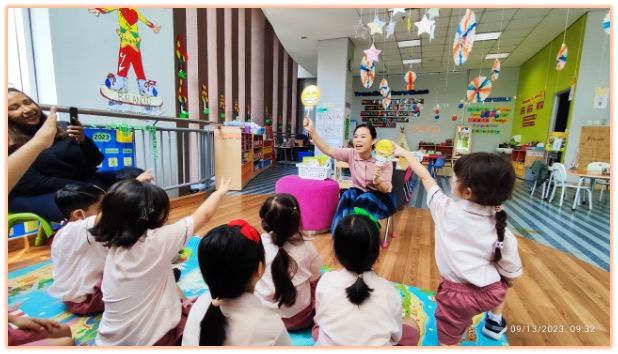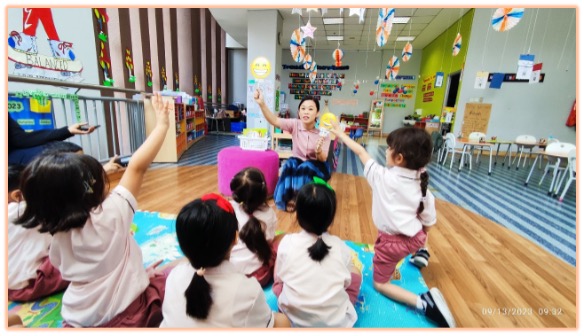children
Everyone loves a story
Everyone grew up with storytelling. The importance of storytelling for children cannot be underestimated. Storytelling is part of everybody’s childhood. During this stage, children are filled with questions, creativity, imagination, inspiration, and ideas. Storytelling helps children develop empathy and respect for others while also improving fundamental reading and writing skills.
The meaning of storytelling
Storytelling is the activity of sharing or presenting a story for different purposes such as learning and entertainment. It is a two-way interaction between the storyteller and one or more listeners. Stories can be sad, dramatic, or funny. Telling a story builds an emotional connection between the storyteller and the listener. Text to self, text to text, and text to world connections are also developed.


The importance of storytelling for children
- Improves language skills
Storytelling improves language skills by introducing children to varied vocabulary, new words, phrases, sentence structures and develop their reading skills.
- Enhances cognitive skills
Listening to and taking part in storytelling improve understanding, memory, and critical thinking abilities and communication skills.
- Develops moral understanding
Many stories teach important lessons about right and wrong, good or bad and taking decisions. Children learn important lessons such us kindness, generosity and honesty as well as cultural values from stories.
- Promotes imagination and creativity
Storytelling is an effective technique to encourage children’s imagination and curiosity. It can help children improve their communication and creativity. Both fiction and non-fiction stories develop their imaginative and creative thinking skills.
- Develops social skills
Listening and discussing stories in a group encourage interaction among the children. Children learn how to take turns and share ideas.
- Improves memory
Retelling stories help children increase memory by remembering the characters, plot, setting, problem, and solution.
Indeed, storytelling is important for children’s development. Children enjoy stories. Storytelling helps to deliver information in a meaningful and enjoyable way, making it easier for children to grasp and remember concepts. It also helps children create their new world, emotions, and ideas.
By: Eka Fridayanti
Elementary Co-Teacher
BINUS School Simprug
efridayanti@binus.edu
Reflections from the IB Dunia Early Years Job Alike Session – March 2nd – 2024 Global Jaya School
The learning environment is so important in early childhood education. As teachers, we put careful thought into designing our classrooms to be warm, welcoming, and engaging places for young children to learn and grow. When I think about my kindergarten classroom, I try to make it feel like a home away from home with different learning centers for art, science, reading, math, dramatic play, and more. I want the children to feel comfortable and safe to explore their interests.

According to the International Baccalaureate Organization (IBO), in a resource on the Primary Years Programme (PYP) titled ‘Learning Spaces’.
“A fundamental part of effective education in the PYP early years is the creation of safe, stimulating and inviting learning spaces that promote exploration, wonder, creativity, risk-taking and learning through play.”

This full-day workshop exploring how to intentionally design learning spaces for young students, was very stimulating. I loved hearing perspectives from teachers across schools. It was a lively, collaborative day that gave me many takeaways. The physical environment impacts everything from student motivation and collaboration to nurturing curiosity and inclusion. Key elements include making spaces age- appropriate, flexible, warm, and welcoming; the room layout, organization, and displays should all be closely to learning outcomes.
Arranging the furniture and learning materials in a way that promotes collaboration and discovery. Low, open shelves allow children to access materials independently and make choices. Round tables encourage children to talk and share ideas together. Interest centers with rich, open-ended materials spark curiosity, creativity and imagination. Displays of student work and documentation on the walls validate the children as capable learners. Even small details like lamps, plants, soft rugs, and family photos work to create a nurturing environment. As a teacher, I see myself as a warm facilitator of learning as the children engage with the thoughtfully prepared classroom environment. I continuously reflect on how to improve our space to best support the learning, development and joy of each unique child.

Also, I think that involving the students more in reorganizing classroom areas based on their interests and needs, perhaps creating a cozier reading corner with soft seating and baskets of books to invite deep reading time, could be beneficial. Continue to refresh displays with student work and documentation that make the learning visible.
Here are some examples of learning environments in an early childhood classroom:
* Reading Corner – This area is filled with comfortable cushions, pillows, bean bag chairs, and rocking chairs along with a wide selection of books organized by topics, reading levels, genres, etc. This invites children to cozy up and enjoy books independently or with friends.
* Drama/Pretend Play Area – Filled with child-sized wooden kitchen appliances, costumes, puppets, play food and accessories. This area sparks roleplay and imagination as children engage in dramatic scenarios.
* Block/Construction Area – Stocked with wooden blocks, Lego bricks, Magna-Tiles, and other building materials. Children design and create structures while developing spatial reasoning and cooperation skills.
* Art Center – An open space with a variety of art media including paint, clay, collage materials, pipe cleaners, beads, etc. Promotes creativity and self-expression.
* Science/Discovery Area – Materials for hands-on exploration of science concepts like magnets, gears, natural specimens, magnifying glasses, measuring tools, etc. Nurtures curiosity and inquiry.
* Math Manipulatives – Wide array of counting bears, pattern blocks, scales, rulers, and other math materials. Develops math sense and problem solving in a tactile way.
* Outdoor Classroom – Garden beds, logs, playhouse, sand/water tables and more take learning outside. Being in nature brings concepts alive.
As teachers, we should not underestimate the power of the physical environment you create. Even small details can have a significant impact on learning. The key is creating diverse spaces for active, meaningful, joyful learning through play and exploration. The environment is the teacher! It takes work, but I am sure it is rewarding.
By
Ria Agustina
Kindergarten Teacher
ACG School Jakarta
